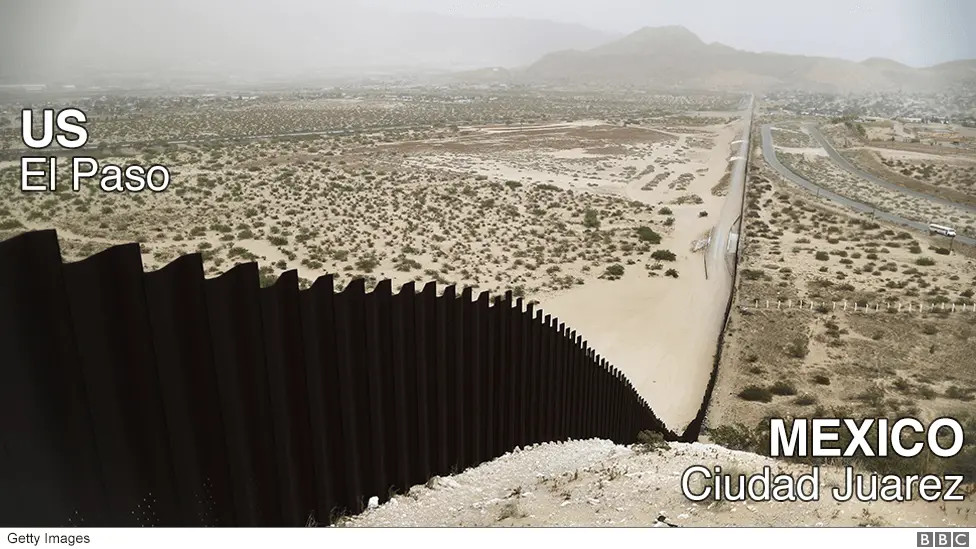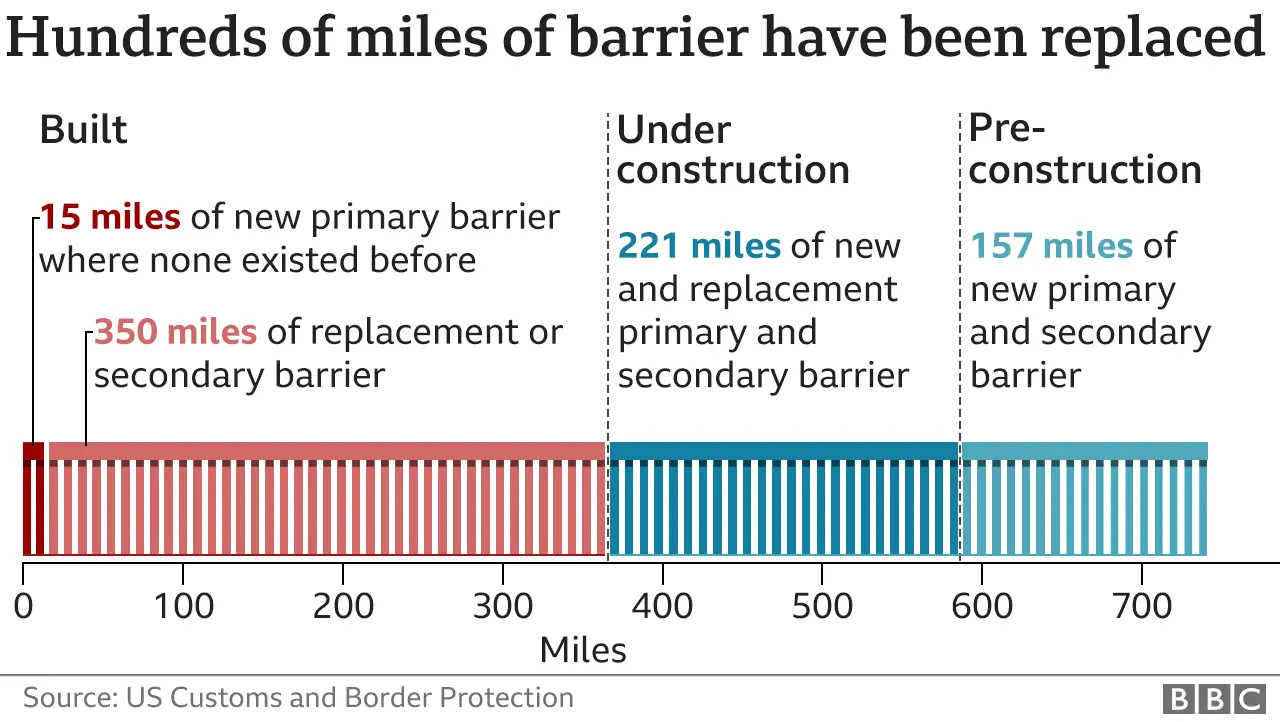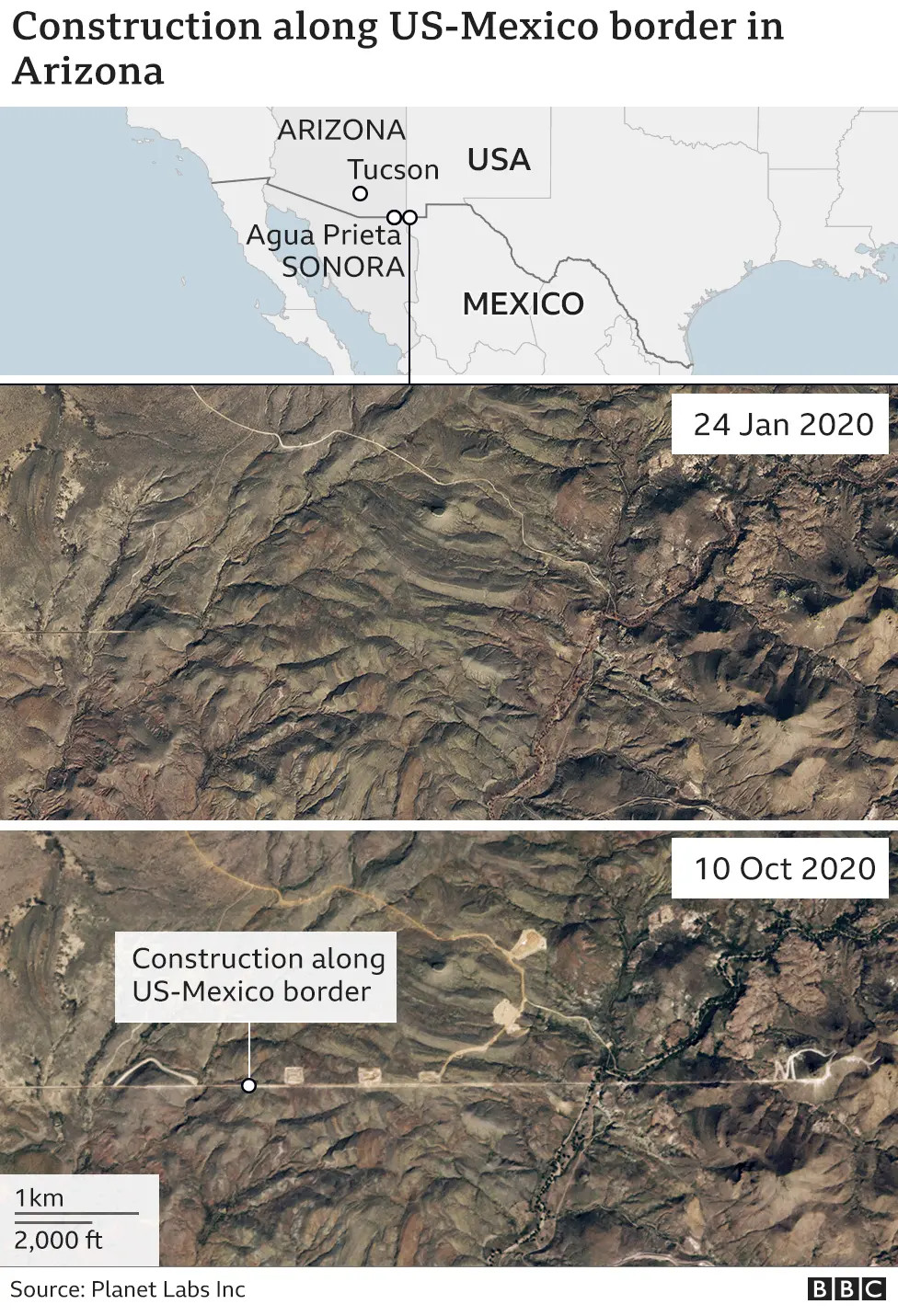The border between the U.S. and Mexico stretches approximately 1,954 miles (3,145 kilometers), creating a unique intersection of cultures, economies, and histories. At gaymexico.net, we provide comprehensive information and resources for LGBTQ+ travelers and those interested in Mexican culture. Discover the best travel destinations, safe spaces, and LGBTQ+ events in Mexico.
1. What Factors Determine the Border Length Between the US and Mexico?
The border between the United States and Mexico spans approximately 1,954 miles (3,145 kilometers). Understanding the factors that influence this measurement provides crucial context for discussions about immigration, trade, and cultural exchange along this extensive boundary. The key factors determining the border length are:
- Natural Geography: The Rio Grande River forms a significant portion of the border, and its meandering course contributes to the overall length. According to the International Boundary and Water Commission (IBWC), the river’s path is subject to natural shifts, which can subtly alter the measured border length over time.
- Surveying Techniques: Modern surveying technologies, including GPS and satellite imagery, offer increasingly precise measurements. Different techniques and standards used over the years have resulted in varying figures for the border length.
- Political Agreements: Historical treaties and agreements between the U.S. and Mexico have defined the border’s legal and physical parameters. The Treaty of Guadalupe Hidalgo in 1848 and subsequent agreements have shaped the demarcation and maintenance of the border.
Knowing these factors can help one to better appreciate the complexities involved in managing and studying the border between the U.S. and Mexico.
2. Which States Share a Border with Mexico?
Four U.S. states share a border with Mexico: California, Arizona, New Mexico, and Texas. These states not only share a physical boundary but also a rich tapestry of cultural, economic, and social interactions.
- California: As the most populous state, California shares a border with Mexico that is approximately 140 miles long. The busiest land border crossing in the western hemisphere, San Ysidro, connects San Diego with Tijuana.
- Arizona: Arizona’s border with Mexico extends roughly 373 miles. The state has significant cross-border traffic and unique challenges related to immigration and border security.
- New Mexico: Sharing about 180 miles of border with Mexico, New Mexico is characterized by its diverse landscapes and cultural heritage.
- Texas: Texas has the longest border with Mexico, stretching approximately 1,254 miles. The Rio Grande River forms the majority of this border, impacting trade, immigration, and environmental issues.
Each of these states has unique economic, cultural, and social ties to Mexico, fostering a complex relationship that affects the entire region.
3. What is the Significance of the US-Mexico Border?
The U.S.-Mexico border carries immense significance due to its complex interplay of economic, cultural, and political factors. It is more than just a line separating two countries; it’s a region of intense interaction and interdependence. Here’s why it matters:
- Economic Impact: The border region facilitates billions of dollars in trade annually. According to the U.S. Trade Representative, the U.S.-Mexico-Canada Agreement (USMCA) supports significant cross-border commerce, vital for numerous industries in both countries.
- Cultural Exchange: The border region is a vibrant hub of cultural exchange, blending traditions, languages, and lifestyles. This melting pot enriches the social fabric of both nations but also presents unique challenges in managing cultural integration.
- Migration and Immigration: The border is a focal point for migration and immigration, with significant implications for both countries. The Pew Research Center has extensively documented migration patterns, highlighting the socio-economic factors driving movement across the border.
- Security Concerns: The border is a zone of security concerns, including drug trafficking, human smuggling, and border-related violence. These issues require coordinated efforts by both governments to ensure safety and stability.
Understanding these factors is crucial for informed discussions about border policy, international relations, and the well-being of communities on both sides. For the LGBTQ+ community, knowing the socio-political landscape is especially important for safe and informed travel.
 San Ysidro Border Crossing at Night
San Ysidro Border Crossing at Night
San Ysidro Border Crossing at Night: The San Ysidro Port of Entry between San Diego and Tijuana, captured at night, illustrates the bustling activity and connectivity that characterizes the US-Mexico border.
4. How Does the Border Affect LGBTQ+ Travel to Mexico?
For LGBTQ+ individuals planning to travel to Mexico, understanding the border’s dynamics is crucial for ensuring a safe and enjoyable experience. Several factors come into play:
- Safety and Security: Some border cities have higher crime rates, which can affect LGBTQ+ travelers. Researching specific destinations and staying informed about local conditions is essential. Resources like travel advisories from the U.S. State Department and LGBTQ+ travel guides can provide valuable insights.
- Legal Considerations: While Mexico has made strides in LGBTQ+ rights, local laws and attitudes can vary. Familiarizing yourself with the legal landscape and cultural norms of your destination is important. Organizations like the Human Rights Campaign offer information on LGBTQ+ rights in different countries.
- Cultural Sensitivity: Respecting local customs and traditions is key to a positive travel experience. While Mexico is generally welcoming, public displays of affection may be viewed differently in certain areas. Being aware and respectful of local norms helps ensure a comfortable visit.
- Access to LGBTQ+ Resources: Major cities and tourist destinations often have established LGBTQ+ communities and resources. Knowing where to find LGBTQ+-friendly establishments and support networks can enhance your travel experience. Websites like gaymexico.net offer listings of gay bars, clubs, and accommodations in Mexico.
Being informed and prepared can significantly enhance the safety and enjoyment of LGBTQ+ individuals traveling to Mexico.
5. What are the Key Border Crossings Between the US and Mexico?
Several key border crossings facilitate the flow of people, goods, and services between the U.S. and Mexico. Each crossing has unique characteristics and plays a vital role in international trade and travel.
- San Ysidro (California/Tijuana): As the busiest land border crossing in the Western Hemisphere, San Ysidro processes thousands of vehicles and pedestrians daily.
- El Paso (Texas/Ciudad Juárez): This crossing is critical for trade and cultural exchange, connecting two large metropolitan areas.
- Laredo (Texas/Nuevo Laredo): Laredo is the busiest inland port on the U.S.-Mexico border, handling a significant volume of commercial traffic.
- Calexico (California/Mexicali): This crossing facilitates both commercial and tourist traffic, supporting the economies of both regions.
- Nogales (Arizona/Nogales): Nogales is an important port for agricultural trade and tourism.
These crossings are vital nodes in the U.S.-Mexico relationship, impacting everything from trade to tourism. Understanding their significance helps one appreciate the complexities of cross-border interactions.
6. What Challenges Exist Along the US-Mexico Border?
The U.S.-Mexico border region faces numerous challenges, including issues related to immigration, security, and environmental sustainability. Addressing these challenges requires coordinated efforts from both countries and a comprehensive understanding of their root causes.
- Immigration Issues: Managing the flow of migrants and asylum seekers is a significant challenge, requiring humane and effective policies. The Migration Policy Institute provides detailed analysis and data on immigration trends and policies.
- Security Concerns: Combating drug trafficking, human smuggling, and border-related violence requires enhanced law enforcement and intelligence cooperation. The U.S. Department of Homeland Security works with Mexican authorities to address these issues.
- Environmental Concerns: The border region faces environmental challenges such as water scarcity, pollution, and habitat destruction. The International Boundary and Water Commission (IBWC) addresses these issues through bi-national cooperation.
- Economic Disparities: Addressing economic disparities on both sides of the border is crucial for fostering stability and reducing incentives for illegal activities. Programs aimed at promoting economic development and job creation can help mitigate these disparities.
Understanding these challenges is crucial for developing informed policies and fostering a more secure and prosperous border region.
7. How Have Border Security Measures Changed Over Time?
Border security measures have evolved significantly over time in response to changing political, economic, and social conditions. Understanding this evolution provides insight into current border policies and their impact.
- Early 20th Century: Initial efforts focused on basic border control and customs enforcement.
- Mid-20th Century: Increased emphasis on combating illegal immigration and drug trafficking. The establishment of the U.S. Border Patrol in 1924 marked a significant step in formalizing border enforcement.
- Late 20th Century: The implementation of Operation Gatekeeper in California and Operation Hold-the-Line in Texas in the 1990s led to increased border fencing and personnel.
- Post-9/11 Era: Heightened security measures, including increased surveillance technology and stricter enforcement policies, were implemented in response to terrorism concerns.
- Recent Developments: The construction of additional border walls and enhanced technology deployments have been central to recent border security strategies.
These changes reflect an ongoing effort to balance security concerns with economic and humanitarian considerations.
 Border Fence Between US and Mexico
Border Fence Between US and Mexico
Border Fence Between US and Mexico: A section of the border fence illustrates the physical barrier between the two countries, reflecting efforts to control and manage cross-border movement.
8. What is the Role of the Border Patrol?
The U.S. Border Patrol plays a crucial role in securing the nation’s borders, with a primary focus on preventing illegal entry of individuals and contraband. Understanding its responsibilities and operations is essential for grasping border dynamics.
- Responsibilities: The Border Patrol is responsible for detecting and apprehending individuals attempting to enter the U.S. illegally, as well as interdicting drugs and other contraband.
- Operations: Agents patrol the border using a variety of methods, including vehicle patrols, foot patrols, and surveillance technology. They work in collaboration with other law enforcement agencies to address border security threats.
- Training: Border Patrol agents undergo extensive training in law enforcement, immigration law, and cultural sensitivity.
- Challenges: The Border Patrol faces numerous challenges, including vast and often remote terrain, evolving smuggling tactics, and humanitarian concerns related to migrants and asylum seekers.
The Border Patrol’s role is integral to maintaining border security and enforcing immigration laws.
9. How Does Trade Affect the US-Mexico Border Region?
Trade is a cornerstone of the U.S.-Mexico relationship, significantly impacting the economies of both countries and the communities along the border.
- Economic Interdependence: The U.S. and Mexico are major trading partners, with billions of dollars in goods and services crossing the border annually. The U.S. Trade Representative provides data on trade flows and agreements.
- NAFTA/USMCA: The North American Free Trade Agreement (NAFTA) and its successor, the U.S.-Mexico-Canada Agreement (USMCA), have shaped trade relations, reducing tariffs and fostering economic integration.
- Border Economies: Communities along the border often depend heavily on cross-border trade for jobs and economic opportunities. Disruptions to trade flows can have significant impacts on these communities.
- Supply Chains: The U.S. and Mexico are integrated into complex supply chains, with goods often crossing the border multiple times during the manufacturing process.
Understanding the economic dynamics of the border region is crucial for informed policy-making and fostering sustainable development.
10. What are Some Cultural Aspects of the US-Mexico Border Region?
The U.S.-Mexico border region is a rich mosaic of cultural influences, blending traditions, languages, and lifestyles from both countries.
- Language: Spanish and English are commonly spoken, often in a mix known as “Spanglish,” reflecting the bilingual nature of the region.
- Cuisine: The border region boasts a unique culinary heritage, blending Mexican and American flavors. Dishes like Tex-Mex and Cal-Mex reflect this fusion.
- Music and Arts: Music and art forms often reflect the cultural exchange between the two countries. Genres like Tejano music and Chicano art celebrate the border’s unique cultural identity.
- Festivals and Traditions: Numerous festivals and traditions celebrate the shared heritage of the region, fostering a sense of community and cultural pride.
Exploring these cultural aspects provides a deeper appreciation of the border region’s unique identity. For LGBTQ+ travelers, experiencing this vibrant culture can be particularly rewarding.
11. What Types of Infrastructure are Present Along the US-Mexico Border?
The infrastructure along the U.S.-Mexico border is extensive and varied, reflecting the complex needs of security, trade, and transportation. Key components include:
- Border Fencing and Walls: Physical barriers range from simple fences to reinforced walls, designed to deter illegal crossings.
- Ports of Entry: These facilities handle the processing of people and goods entering and exiting the U.S. and Mexico. They include inspection stations, customs offices, and immigration checkpoints.
- Roads and Highways: A network of roads and highways facilitates the movement of goods and people along the border.
- Bridges: Bridges span the Rio Grande and other waterways, connecting communities and facilitating trade.
- Surveillance Technology: Surveillance technology includes cameras, sensors, and drones, used to monitor border activity and detect illegal crossings.
This infrastructure is crucial for managing the flow of people and goods, as well as maintaining security along the border.
12. How Do Environmental Factors Impact the US-Mexico Border?
Environmental factors significantly impact the U.S.-Mexico border region, posing challenges to both ecosystems and human communities.
- Water Scarcity: Water scarcity is a major concern, particularly in arid and semi-arid regions. The Colorado River and Rio Grande are vital water sources, but they are under increasing pressure from population growth and climate change.
- Pollution: Industrial and urban pollution affects air and water quality along the border. The Border Environment Cooperation Commission (BECC) addresses pollution issues through binational cooperation.
- Habitat Destruction: Development and land use changes have led to habitat destruction, threatening biodiversity and ecosystem services.
- Climate Change: Climate change is exacerbating environmental challenges, leading to more frequent and intense droughts, floods, and heatwaves.
Addressing these environmental factors requires sustainable management practices and binational cooperation to protect the region’s natural resources.
 Trump Wall at US Mexico Border
Trump Wall at US Mexico Border
Trump Wall at US Mexico Border: The image shows recent construction work along the border, highlighting the physical changes and infrastructure development.
13. What is the Impact of US Immigration Policies on the Border Region?
U.S. immigration policies have a profound impact on the border region, influencing migration patterns, border security measures, and the lives of individuals and communities.
- Enforcement Policies: Stricter enforcement policies can lead to increased border crossings in remote and dangerous areas, as well as increased detention and deportation rates.
- Asylum Policies: Changes in asylum policies can affect the number of asylum seekers arriving at the border and their access to protection.
- Border Security Spending: Increased spending on border security can lead to more infrastructure and personnel, but also raises concerns about human rights and environmental impacts.
- Economic Impacts: Immigration policies can affect the availability of labor and the economic competitiveness of border communities.
Understanding these impacts is crucial for developing immigration policies that are both effective and humane.
14. How Do Indigenous Communities Relate to the US-Mexico Border?
Indigenous communities have deep historical ties to the land that spans the U.S.-Mexico border, and the border has had a significant impact on their lives and cultures.
- Traditional Lands: The border divides traditional lands of many indigenous groups, disrupting their cultural practices and social networks.
- Cross-Border Movement: Indigenous people often cross the border for cultural, religious, and family reasons, but they may face challenges due to immigration laws and border enforcement.
- Cultural Preservation: Efforts to preserve indigenous languages and traditions are vital, but they can be complicated by the border’s presence.
- Economic Development: Indigenous communities often face economic challenges, and cross-border trade and tourism can offer opportunities for economic development.
Recognizing and respecting the rights and needs of indigenous communities is essential for fostering a more just and equitable border region.
15. What Advocacy and Support Groups Operate Along the US-Mexico Border?
Numerous advocacy and support groups operate along the U.S.-Mexico border, providing assistance to migrants, asylum seekers, and border communities.
- Legal Aid Organizations: These groups provide legal representation and advice to migrants and asylum seekers.
- Humanitarian Aid Groups: These groups provide food, shelter, medical care, and other assistance to migrants and asylum seekers.
- Immigrant Rights Groups: These groups advocate for policies that protect the rights of immigrants and promote immigration reform.
- Community Organizations: These groups work to address the needs of border communities, including issues related to economic development, education, and health care.
Supporting these organizations is crucial for ensuring that migrants and border communities have access to the resources and support they need.
16. What Future Trends May Affect the US-Mexico Border?
Several future trends are likely to affect the U.S.-Mexico border, shaping its dynamics and posing new challenges and opportunities.
- Demographic Changes: Population growth and demographic shifts on both sides of the border will influence migration patterns and labor markets.
- Economic Integration: Continued economic integration will increase cross-border trade and investment, but also raise concerns about labor standards and environmental protection.
- Technological Advancements: Technological advancements will transform border security and trade facilitation, but also raise ethical and privacy concerns.
- Climate Change Impacts: Climate change will exacerbate environmental challenges, leading to increased migration and competition for resources.
Addressing these trends requires proactive planning, binational cooperation, and sustainable development strategies.
17. How Can LGBTQ+ Individuals Contribute to Positive Change in the Border Region?
LGBTQ+ individuals can play a significant role in fostering positive change in the U.S.-Mexico border region by promoting inclusivity, advocating for human rights, and supporting community development.
- Promoting Inclusivity: By sharing their stories and experiences, LGBTQ+ individuals can help promote understanding and acceptance of diverse sexual orientations and gender identities.
- Advocating for Human Rights: LGBTQ+ individuals can advocate for policies that protect the rights of all individuals, regardless of their sexual orientation or gender identity.
- Supporting Community Development: LGBTQ+ individuals can support community development initiatives that address the needs of border communities, including issues related to economic development, education, and health care.
- Building Alliances: By building alliances with other advocacy groups and community organizations, LGBTQ+ individuals can amplify their impact and promote positive change.
By actively engaging in these efforts, LGBTQ+ individuals can contribute to a more just and equitable border region.
18. What Resources are Available for Those Living Near the US-Mexico Border?
Numerous resources are available for individuals and families living near the U.S.-Mexico border, providing assistance with issues related to immigration, health care, education, and economic development.
- Immigration Legal Services: Organizations offer free or low-cost legal assistance to immigrants and asylum seekers.
- Health Care Clinics: Community health centers provide medical care to uninsured and underinsured individuals.
- Educational Programs: Schools and community organizations offer educational programs for children and adults, including ESL classes and GED preparation.
- Job Training Programs: Workforce development agencies provide job training and placement services to help individuals find employment.
- Social Services Agencies: Social services agencies offer assistance with housing, food, and other basic needs.
Accessing these resources can help individuals and families overcome challenges and thrive in the border region.
19. How Does the Media Portray the US-Mexico Border?
The media plays a significant role in shaping public perceptions of the U.S.-Mexico border, often focusing on issues such as immigration, crime, and security.
- Sensationalism: Some media outlets tend to sensationalize border issues, exaggerating the extent of crime and violence.
- Stereotypes: Media portrayals can perpetuate negative stereotypes about immigrants and border communities.
- Political Bias: Media coverage often reflects the political biases of the news outlet, influencing how border issues are framed.
- Missing Perspectives: The voices of border residents and marginalized communities are often missing from media coverage.
Critically evaluating media portrayals of the border is essential for developing a more nuanced and informed understanding of the region.
20. What Can Travelers Expect When Crossing the US-Mexico Border?
Travelers crossing the U.S.-Mexico border should be prepared for potential delays, security checks, and questioning by border officials.
- Documentation: Travelers must have valid documentation, such as a passport or border crossing card.
- Inspections: Vehicles and luggage may be subject to inspection by customs officials.
- Questioning: Border officials may ask travelers about their purpose of travel, destination, and other relevant information.
- Wait Times: Wait times at border crossings can vary depending on the time of day and the volume of traffic.
- Safety Precautions: Travelers should be aware of their surroundings and take precautions to protect their safety and belongings.
Being prepared and informed can help ensure a smooth and stress-free border crossing experience.
 Border Patrol Vehicle Near Fence
Border Patrol Vehicle Near Fence
Border Patrol Vehicle Near Fence: A Border Patrol vehicle patrolling near the border fence, highlighting the presence of law enforcement and security measures in the area.
21. What Role Does Technology Play in Border Security?
Technology plays an increasingly important role in enhancing border security, with advancements in surveillance, detection, and communication systems.
- Surveillance Systems: Cameras, sensors, and drones are used to monitor border activity and detect illegal crossings.
- Detection Technology: Advanced screening technologies are used to detect drugs, weapons, and other contraband.
- Communication Systems: Secure communication systems enable border agents to coordinate their efforts and respond to security threats.
- Data Analytics: Data analytics tools are used to identify patterns and trends in border activity, helping law enforcement agencies to allocate resources effectively.
While technology can enhance border security, it also raises concerns about privacy and civil liberties.
22. How Do US and Mexican Laws Differ Along the Border?
Significant differences exist between U.S. and Mexican laws, impacting issues such as immigration, drug policy, and environmental protection.
- Immigration Laws: U.S. immigration laws are stricter than Mexican laws, leading to differences in border enforcement and deportation policies.
- Drug Policy: The U.S. and Mexico have different approaches to drug policy, with the U.S. focusing on law enforcement and Mexico exploring alternative approaches, such as decriminalization.
- Environmental Laws: Environmental laws differ between the two countries, leading to challenges in addressing pollution and protecting natural resources along the border.
- Labor Laws: Labor laws differ between the U.S. and Mexico, impacting wages, working conditions, and labor standards in the border region.
Understanding these legal differences is essential for navigating the complexities of the border region.
23. What are Some Common Misconceptions About the US-Mexico Border?
Numerous misconceptions exist about the U.S.-Mexico border, often fueled by biased media coverage and political rhetoric.
- The Border is a War Zone: While the border region faces security challenges, it is not a war zone. Most border communities are safe and peaceful.
- All Immigrants are Criminals: The vast majority of immigrants are law-abiding individuals seeking to improve their lives.
- The Border Wall Will Solve All Problems: A border wall is not a comprehensive solution to border challenges, and it can have negative environmental and social impacts.
- The Border is Only About Immigration: The border is a complex region with diverse economic, cultural, and environmental issues that go beyond immigration.
Challenging these misconceptions is essential for promoting a more accurate and nuanced understanding of the U.S.-Mexico border.
24. How Has the Border Influenced Art and Literature?
The U.S.-Mexico border has served as a source of inspiration for artists and writers, who explore themes of identity, migration, and cultural exchange.
- Chicano Art: Chicano art often reflects the experiences of Mexican Americans living in the border region, celebrating their cultural heritage and advocating for social justice.
- Border Literature: Border literature explores the complexities of life on the border, portraying the challenges and opportunities faced by border residents.
- Music: Musicians draw inspiration from the border’s diverse cultural influences, creating unique sounds that blend Mexican and American traditions.
- Film: Filmmakers have used the border as a backdrop for stories that explore themes of migration, identity, and cross-cultural relations.
Exploring art and literature related to the border can provide a deeper appreciation of its cultural richness and complexities.
25. How Can I Learn More About the US-Mexico Border?
Numerous resources are available for those seeking to learn more about the U.S.-Mexico border, including books, websites, and academic institutions.
- Books: Explore non-fiction and fiction books that offer insights into the border’s history, culture, and challenges.
- Websites: Visit websites of organizations that conduct research and advocacy related to the border, such as the Migration Policy Institute and the Border Network for Human Rights.
- Academic Institutions: Universities offer courses and programs related to border studies, providing opportunities for in-depth learning and research.
- Documentaries: Watch documentaries that explore the border’s complexities, offering perspectives from border residents, experts, and policymakers.
By exploring these resources, you can gain a more comprehensive and nuanced understanding of the U.S.-Mexico border.
 Getty Images Donald Trump at the new barrier
Getty Images Donald Trump at the new barrier
Getty Images Donald Trump at the new barrier: A photograph showing Donald Trump at a newly constructed section of the border barrier, emphasizing political interest and infrastructure development.
For LGBTQ+ travelers and individuals interested in Mexico, the U.S.-Mexico border represents a complex intersection of cultures, economies, and histories. Whether you’re planning a trip to Mexico, seeking to connect with the LGBTQ+ community, or simply interested in learning more about this dynamic region, gaymexico.net is your go-to resource. Explore our travel guides, discover LGBTQ+-friendly destinations, and stay informed about the latest news and events. Connect with our community today and start your journey of discovery.
Explore the best of Mexico with gaymexico.net.
Address: 3255 Wilshire Blvd, Los Angeles, CA 90010, United States
Phone: +1 (213) 380-2177
Website: gaymexico.net
FAQ about the US-Mexico Border
-
How long is the US-Mexico border?
The US-Mexico border is approximately 1,954 miles (3,145 kilometers) long.
-
Which US states border Mexico?
California, Arizona, New Mexico, and Texas share a border with Mexico.
-
What are the main issues along the US-Mexico border?
Main issues include immigration, drug trafficking, security concerns, and environmental challenges.
-
How has border security changed over time?
Border security has evolved from basic control to enhanced surveillance and infrastructure, especially post-9/11.
-
What is the role of the US Border Patrol?
The US Border Patrol is responsible for detecting and apprehending illegal entrants and interdicting contraband.
-
How does trade affect the border region?
Trade significantly impacts the border region, fostering economic interdependence through agreements like USMCA.
-
What are the cultural aspects of the border region?
The border region is a mix of languages, cuisines, music, and traditions from both countries, creating a unique cultural identity.
-
What kind of infrastructure is along the border?
Infrastructure includes border fencing, ports of entry, roads, bridges, and surveillance technology.
-
What is the impact of US immigration policies on the border?
US immigration policies affect migration patterns, border security measures, and the lives of border communities.
-
How can I learn more about the US-Mexico border?
You can learn more through books, websites, academic institutions, and documentaries focused on border studies.
